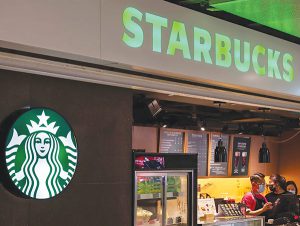Bloomberg
Laxman Narasimhan will take over as Starbucks Corp.’s chief executive officer with a long list of pressing tasks, from redesigning cafes to improving profitability. But perhaps none is as pressing as blunting a fast-spreading US union drive.
It’s a tall order — especially for a leader without experience operating restaurants.
Narasimhan, 55, is coming in from British consumer-goods firm Reckitt Benckiser, where as CEO he overhauled management and strategy to boost the flagging business. Narasimhan, who also held a top role at PepsiCo, starts in October but doesn’t actually take over until April, when interim CEO Howard Schultz will pass the torch to him while remaining an adviser and board member.
Narasimhan’s previous roles have given him extensive experience in building brands and guiding strategic turnarounds. But Starbucks, with its 39,000 locations worldwide, represents a new challenge for the mechanical engineer and Wharton School MBA graduate. The Seattle-based company is struggling to contain a union drive across its US stores while also improving margins in the face of record inflation levels.
Underscoring the challenge, Starbucks workers and union organisers announced a series of actions at 110 US locations on Labour Day to “welcome†the new CEO.
“I was surprised that he’s lacking in restaurant experience with the unionization push going on, and there’s a lot of other stuff,†Bloomberg Intelligence analyst Michael Halen said. “He’s coming from a different side of the business.â€
Workers United, which has helped unionise more than 200 Starbucks US cafes, has accused the chain of anti-union tactics under Schultz’s leadership such as threatening and firing baristas that are involved in labour organisation. Starbucks says it follows labour laws and denies any wrongdoing. While the firm raised its average US wage to $17 an hour and vows to improve worker training, the union push has continued.
“We are hopeful that Narasimhan will end Starbucks’s scorched-earth union-busting campaign,†barista Michelle Eisen said in a statement from Workers United. “This is the perfect opportunity for Starbucks to end the wrongful terminations, store closings and war against workers.â€
Reckitt Benckiser’s reports show that some of its employees belong to a union. The company employs more than 40,000 overall, including about 5,300 in the US, whereas Starbucks has more than 380,000 workers, with about 245,000 of those in the US.
“The stores are unionizing, and you’re obviously bringing in someone who has no idea about the plight of someone who works in a fast-food restaurant,†Halen said. “Will he be able to relate to the hourly workers at Starbucks?â€
That may be why there’s an extended six-month window before Schultz, 69, passes the reins to Narasimhan. Analysts see Schultz as a charismatic leader who has conducted listening sessions with workers at stores across the country since returning earlier this year.
One has to wonder “what incremental influence this leader may have on these plans once fully aboard,†Citigroup analyst Jon Tower said in a research note. “We think this will need to be fleshed out at the investor event in order to gain greater long-term investor interest.â€
Union leaders are also wondering how much influence Schultz will wield even after he leaves the CEO role. Richard Bensinger, a Workers United organizer and architect of the Starbucks campaign, said he questions whether Narasimhan “is actually going to be making any decisions.†Bensinger blamed Schultz for the current animosity between workers and management.
“Hopefully the new CEO is going to be able to run the company his way, and hopefully his way is one that respects a diversity of opinions and respects the right to organize,†he said in an interview.
While Starbucks suspended guidance for the rest of the current fiscal year amid high inflation and economic uncertainty, its latest results show that demand for $5 lattes has persisted even as some US consumers cut back on spending. Strong results in Starbucks’s home market, however, have been offset by sluggishness in China, where the chain has about 5,700 stores. The recovery there will be nonlinear, Starbucks has said, as it’s complicated by rolling Covid restrictions.
Meanwhile, investors are eager for Schultz’s strategic plan to be hashed out in better detail. The company has been toying with smaller, pickup-only stores. It also has a history of shuttering locations and reopening them with revamped interiors that better cater to customers’ needs. Drive-thru is a priority, too. Starbucks is also introducing new brewing equipment and improving training to make baristas’ jobs easier.
 The Gulf Time Newspaper One of the finest business newspapers in the UAE brought to you by our professional writers and editors.
The Gulf Time Newspaper One of the finest business newspapers in the UAE brought to you by our professional writers and editors.
